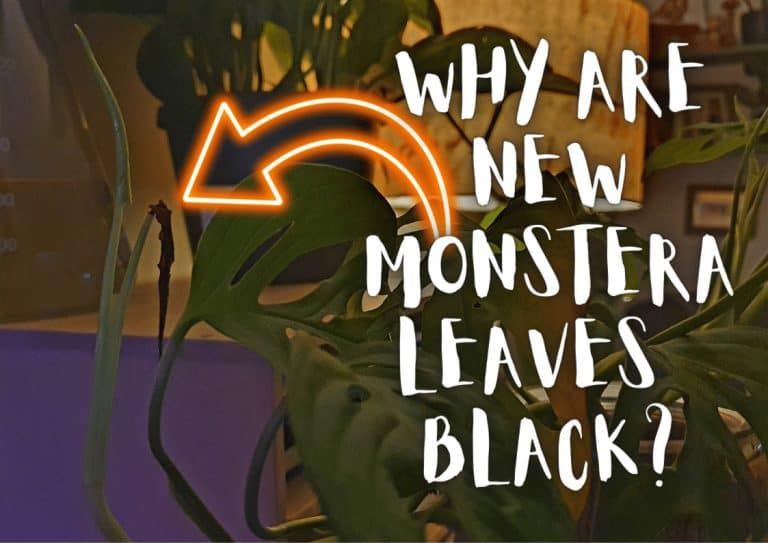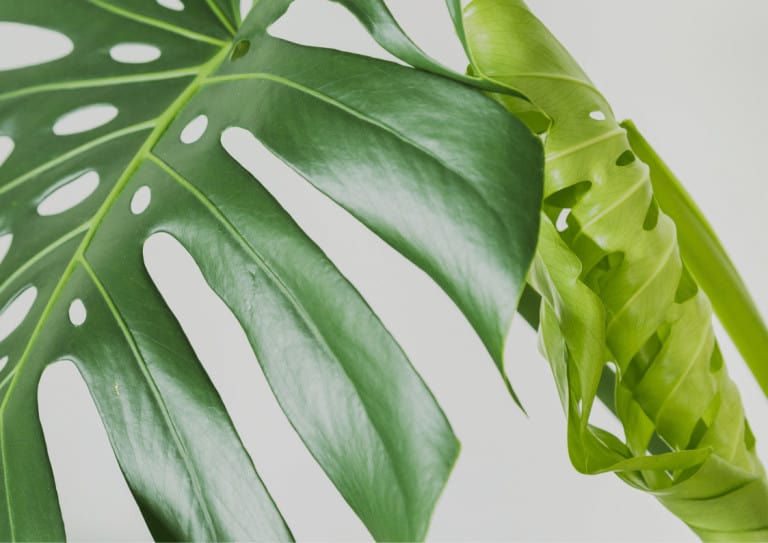Why Are New Leaves On My Monstera Black?
- Lakeisha Ethans
- March 27, 2022
If you buy something using the retail links in our articles, sometimes we earn a small affiliate commission. This does not impact the products we recommend.
Monstera plants are relatively hardy and aren’t that easy to kill or damage accidentally.
But they also require specific care, and when they don’t get that care, they’ll let you know relatively quickly. This “communication” from the plant comes in the form of obvious oddities in the it’s appearance.
In Monstera, this often happens when leaves are colored a dark brown or black shade before they even begin to unfurl. Naturally this can be a huge concern for plant owners as there are few things more distressing than seeing dead or dying leaves on a plant that you thought was healthy. So why might this happen?
There are many reasons why a Monstera’s new leaves may be turning black or brown as soon as they develop; however the most likely cause is an imbalance of moisture in the soil, causing hydration in plant tissues to become disrupted.
In addition to water being the source of the problem there are a few other possibilities. In this article, we’ll attempt to give you some ideas as to where you can start determining the cause of your Monstera’s issues.
Some things we’ll look at include:
- How moisture imbalances can cause black Monstera leaves
- How sub-optimal growing conditions cause new Monstera leaves to turn black?
- Diseases or pests that cause new Monstera leaves to turn black?
- How to fix black Monstera leaves?

Moisture imbalance can cause new Monstera leaves to turn black
Moisture balance issues are the most common causes of new leaves growing in black for Monstera plants. This may be because of under-watering or using water that is of poor quality.
Dehydration is a slow but deadly issue, often not showing up quickly because of the thickness of a Monstera’s leaves. New leaves may grow in crispy and black because the plant doesn’t have enough water to hydrate this fresh growth. You might also notice this happening on old leaves, especially those farthest from the stem. Drooping and wilting will follow.
Giving a Monstera too much water can put them at severe risk of root rot, which occurs when roots are stuck in too-damp soil. However this usually causes yellowing leaves and mushy stems, rather than all black foliage.
Finally, consider the quality of the water that you’re using.Contaminated water can harm your plant and slowly kill it, with new leaves falling victim first as the plant attempts to limit damage. Use a water filter if necessary!
Our Favorite Monstera Plants And Supplies On Etsy
What growing conditions cause new Monstera leaves to turn black?
New leaves are the most sensitive to disturbance on Monstera plants, so if sub-optimal conditions are present, new growth won’t be able to survive and they’ll be dead soon after growing in.
A lack of sufficient humidity is a common cause for suboptimal Monstera growth conditions. Monstera plants are tropical and need humidity of 40% or higher. Without that, black patches will begin to crisp up leaf edges and will wilt new leaves as the plant loses moisture.
Next, you should also consider the temperature of your Monster’s environment. Once again due to their tropical heritage, these beautiful plants don’t take well to the cold. Freezing leaves will develop black marks on them, and new leaves may die very quickly in the cold.
Sunburn may also be a potential issue. If you keep your Monstera plant outdoors and not in a shaded area, its leaves may get scorched from the direct bright sunlight. You may have noticed this issue on older leaves, too, but new leaves will have even less of a chance of survival against the sun.
Lastly, your Monstera may not be sufficiently fertilized. Yellowing, hole-filled leaves are often a sign of too-little nutrients. Conversely, black leaves may occur due to excessive fertilization, too, so you’ll need to strike a balance.
Can diseases or pests cause new Monstera leaves to be black?
The first thought that might jump into your head when you see your Monstera’s leaves growing black is of something serious, like a pest infestation or disease. Could these be the cause?
Monstera leaves that are completely brown and black upon growing in are rarely ever caused by disease or pests. In most cases, pests and diseases will cause black spots rather than entirely black leaves, and will leave symptoms of the issue on pre-existing leaves also.
Pest infestations can certainly cause issues with the coloration of leaves. Pests like spider mites and thrips suck out plant sap, leaving black dots on plant tissue. Fungal and bacterial infections can also cause large spots of brown. However, neither of these should cause entirely black new leaves.

Should I cut black leaves off Monstera plants?
Black leaves can be rather unsightly against the lush green of healthy Monstera foliage, so it’s tempting to want to cut them off. But is that a good idea, or could that harm your plant?
It’s okay to cut off black leaves from Monstera plants and is in fact encouraged to prevent diseased or pest-infested tissue from spreading to other parts of the plant. It is also a good idea to do this for root rot. You do not have to remove leaves when they succumb naturally to old age or damage through exposure, but can if you prefer.
How can I fix black Monstera leaves?
The correct way to fix a Monstera producing black leaves depends on the cause of the problem. Figure out the root issue first and then we can address it.
Repotting the plant is usually the first step in dealing with new black leaves on a Monstera plant. Clean the pot entirely and use a fresh growing medium, preferably one which is free draining but has the potential to store and release water to roots when they require it.
Ideally Monstera soil should have
- organic matter that will retain water,
- drainage that prevents roots from being constantly wet
- aeration to allow the roots to breath
- nutrients
- a pH of between 5.5 – 5.7
This lets you almost “reset” the state of the plant, starting over with a clean slate. However, additional steps should be taken depending on the unique cause of these dark leaves.
If overwatering is the problem, cut off discolored or rotting roots with sanitized scissors. Clean the remaining healthy roots, which will be a nice light tan color.
If it’s underwatering that’s the issue, improving the soil quality is normally enough. This is because old soil can become hydrophobic, meaning it may have difficulty absorbing the water that you give to your root system. If this isn’t sufficient, simply increase the watering frequency.
Finally, to finish ensuring your plant’s health, double-check its living conditions. Keep sunlight exposure indirect. Fertilize once a month. Keep temperatures and humidity high. If necessary, implement regular pest control methods and treat infections and diseases as soon as you notice them. This will reduce the risk of future dead on arrival leaves.
Round up
New Monstera leaves that grow in black are most commonly a result of moisture balance issues. However, they can also happen because of poor growing conditions. Pets and diseases may also be a factor, but it’s unlikely that these will cause completely dark new leaves.
As with all plant-related issues, it’s a good idea to get as specific as possible when identifying the problem.
Keep a log considering your plant care habits, and environmental factors in relation to oddities in appearance. This will allow you to narrow down the root cause of the black leaves.

Lakeisha Ethans
Houseplant Writer
Mother to two humans and hundreds of plant babies. Lakeisha uses her 15 years of experience as a content writer to specialise in simplifying what you need to know to grow and care for all indoor plants.
Similar Posts
Do Monstera Produce Seeds As Houseplants? Unveiling The Truth
The Monstera genus are popular houseplants due to their stunning foliage and robust nature, but are they able to produce seeds while being grown indoors?
Is It Possible To Graft Monstera? (Aroid Propagation)
Variegated Monstera plants are rare to come by naturally and cost heaps to buy fully grown. So is it possible to graft a low cost cutting onto a non-variegated plant instead?



